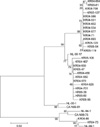1. van den Hoogen BG, de Jong JC, Groen J, Kuiken T, de Groot R, Fouchier RA, Osterhaus AD. A newly discovered human pneumovirus isolated from young children with respiratory tract disease. Nat Med. 2001. 7:719–724.

2. van den Hoogen BG, Bestebroer TM, Osterhaus AD, Fouchier RA. Analysis of the genomic sequence of a human metapneumovirus. Virology. 2002. 295:119–132.

3. Peret TC, Boivin G, Li Y, Couillard M, Humphrey C, Osterhaus AD, Erdman DD, Anderson LJ. Characterization of human metapneumovirus isolated from patients in North America. J Infect Dis. 2002. 185:1660–1663.
4. Boivin G, De Serres G, Cote S, Gilca R, Abed Y, Rochette L, Bergeron MG, Dery P. Human metapneumovirus infections in hospitalized children. Emerg Infect Dis. 2003. 9:634–640.

5. Esper F, Boucher D, Weibel C, Martinello RA, Kahn JS. Human metapneumovirus infection in the United States: clinical manifestations associated with a newly emerging respiratory infection in children. Pediatrics. 2003. 111:1407–1410.

6. Freymouth F, Vabret A, Legrand L, Eterradossi N, Lafay-Delaire F, Brouard J, Guillois B. Presence of the new human metapneumovirus in French children with bronchiolitis. Pediatr Infect Dis J. 2003. 22:92–94.
7. Maggi F, Pifferi M, Vatteroni M, Fornai C, Tempestini E, Anzilotti S, Lanini L, Andreoli E, Ragazzo V, Pistello M, Specter S, Bendinelli M. Human metapneumovirus associated with respiratory tract infections in a 3-year study of nasal swabs from infants in Italy. J Clin Microbiol. 2003. 41:2987–2991.

8. Ebihara T, Endo R, Kikuta H, Ishiguro N, Ishiko H, Hara M, Takahashi Y, Kobayashi K. Human metapneumovirus infection in Japanese children. J Clin Microbiol. 2004. 42:126–132.

9. Biovin G, Abed Y, Pelletier G, Ruel L, Moisan D, Cote S, Peret TC, Erdman DD, Anderson LJ. Virological features and clinical manifestations associated with the human metapneumovirus, a new paramyxovirus responsible for acute respiratory tract infections in all age groups. J Infect Dis. 2002. 186:1330–1334.
10. Stockton J, Stephenson I, Fleming D, Zambon M. Human metapneumovirus as a cause of community acquired respiratory illness. Emerg Infect Dis. 2002. 8:897–901.
11. MacKay IM, Jacob KC, Woolhouse D, Waller K, Syrmis MW, Whiley DM, Siebert DJ, Nissen M, Sloots TP. Molecular assay for detection of human metapneumovirus. J Clin Microbiol. 2003. 41:100–105.
12. Peiris JS, Tang WH, Chan KH, Khong PL, Guan Y, Lau YL, Chiu SS. Children with respiratory disease associated with metapneumovirus in Hong Kong. Emerg Infect Dis. 2003. 9:628–633.

13. van den Hoogen BG, Herfst S, Sprong L, Cane PA, Forleo-Neto E, de Swart RL, Osterhaus AD, Fouchier RA. Antigenic and genetic variability of human metapneumoviruses. Emerg Infect Dis. 2004. 10:658–666.

14. Kumar S, Tamura K, Nei M. MEGA 3: Integrated software for molecular evolutionary genetics analysis and sequence alignments. Bioinformatics. 2004. 5:150–163.
15. von Linstow ML, Henrik Larsen H, Eugen-Olsen J, Koch A, Nordmann Winther T, Meyer AM, Westh H, Lundgren B, Melbye M, Hogh B. Human metapneumovirus and respiratory syncytial in hospitalized Danish children with acute respiratory tract infection. Scand J Infect Dis. 2004. 36:578–584.
16. Galiano M, Videla C, Puch SS, Martinez A, Echavarria M, Carballal G. Evidence of human metapneumovirus in children in Argentina. J Med Virol. 2004. 72:299–303.

17. Dollner H, Risnes K, Radtke A, Nordbo SA. Outbreak of human metapneumovirus infection in Norwegian children. Pediatr Infect Dis J. 2004. 23:436–440.
18. Gerna G, Campanini G, Rovida F, Sarasini A, Lilleri D, Paolucci S, Marchi A, Baldanti F, Revello MG. Changing circulation rate of human metapneumovirus strains and types among hospitalized pediatric patients during three consecutive winter-spring seasons. Arch Virol. 2005. 150:2365–2375.

19. Williams JV, Harris PA, Tollefson SJ, Halburnt-Rush LL, Pingsterhaus JM, Edwards KM, Wright PF, Crowe JE Jr. Human metapneumovirus and lower respiratory tract disease in otherwise healthy infants and children. N Engl J Med. 2004. 350:443–450.

20. Robinson JL, Lee BE, Bastien N, Li Y. Seasonality and clinical features of human metapneumovirus infection in children in Northern Alberta. J Med Virol. 2005. 76:98–105.

21. Jartti T, van den Hoogen B, Garofalo RP, Osterhaus AD, Ruuskanen O. Metapneumovirus and acute wheezing in children. Lancet. 2002. 360:1393–1394.

22. Rawlinson WD, Waliuzzaman Z, Carter JW, Belessis YC, Gilbert KM, Morton JR. Asthma exacerbation in children associated with rhinovirus but not human metapneumovirus infection. J Infect Dis. 2003. 187:1314–1318.
23. Viazov S, Ratjen F, Scheidhauer R, Fielder M, Roggendorf M. High prevalence of human metapneumovirus infection in young children and genetic heterogeneity of the viral isolates. J Clin Microbiol. 2003. 41:3043–3045.

24. Bouscambert-Duchamp M, Lina B, Trompette A, Moret H, Motte J, Andreoletti L. Detection of human metapneumovirus RNA sequences in nasopharyngeal aspirates of young French children with acute bronchiolitis by real time reverse transcriptase PCR and phylogenetic analysis. J Clin Microbiol. 2005. 43:1411–1414.
25. Cuevas LE, Nasser AM, Dove W, Gurgel RQ, Greensill J, Hart CA. Human metapneumovirus and respiratory syncytial virus, Brazil. Emerg Infect Dis. 2003. 9:1626–1628.

26. Konig B, Konig W, Arnold R, Werchau H, Ihorst G, Forster J. Prospective study of human metapneumovirus infection in children less than 3 years of age. J Clin Microbiol. 2004. 42:4632–4635.

27. Falsey AR, Erdman D, Anderson LJ, Walsh EE. Human metapneumovirus infections in young and elderly adults. J Infect Dis. 2003. 187:785–790.

28. Carr MJ, McCormack GP, Crowley B. Human metapneumovirus associated respiratory tract infections in the Republic of Ireland during the influenza season of 2003-4. Clin Microbiol Infect. 2005. 11:366–371.







 PDF
PDF ePub
ePub Citation
Citation Print
Print




 XML Download
XML Download